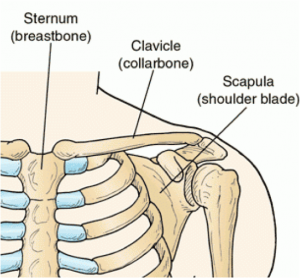anatomy of the shoulder & how shoulder movement is controlled
The shoulder is a ball & socket joint. The ball portion is made up of the knobby end of the humerus (arm bone). The socket portion is located on the scapula (shoulder blade). By design the shoulder joint is very unstable, which is a trade off for the ability to move it in a multitude of directions. Decreased stability equals increased mobility.
 Often overlooked, the scapula plays a crucial role in stability & movement of the shoulder joint. For this reason it deserves to be explored further. The scapula is a complex & fascinating structure. Approaching it from the back, it more or less floats in space hovering over the ribs. Moving to the outside, it makes a lateral connection on the head of the humerus, forming the shoulder joint. The scapula cannot contribute much to joint if it’s just floating in space, thus it needs some sort of connection that anchors it to the central body. Here’s where the collarbone comes into play. The clavicle (collarbone) wraps around the front & links the scapula (shoulder blade) to the midline of the body.
Often overlooked, the scapula plays a crucial role in stability & movement of the shoulder joint. For this reason it deserves to be explored further. The scapula is a complex & fascinating structure. Approaching it from the back, it more or less floats in space hovering over the ribs. Moving to the outside, it makes a lateral connection on the head of the humerus, forming the shoulder joint. The scapula cannot contribute much to joint if it’s just floating in space, thus it needs some sort of connection that anchors it to the central body. Here’s where the collarbone comes into play. The clavicle (collarbone) wraps around the front & links the scapula (shoulder blade) to the midline of the body.
This set up has several implications for how movement is controlled at the shoulder. In the British Journal of Sports Medicine, Kibler & Sciascia (2010) highlight 2 key points….
- The clavicle provides the scapula with important, but minimal, bony stabilization
- Dynamic muscle function is the major method by which the scapula is stabilized & purposefully moved to accomplish its roles.
The scapula depends on the mid back muscles to stabilize it. This makes the muscles surrounding your shoulder blades key! Work your back to…
- prevent shoulder injury
- better control movement
- improve posture & form
- increase weightlifting ability